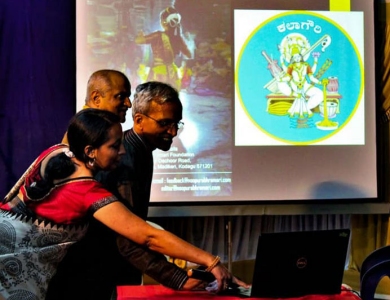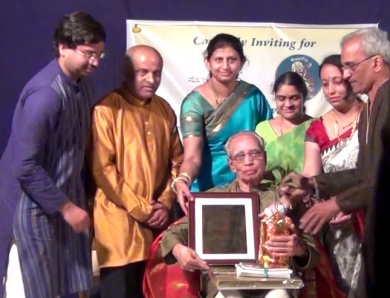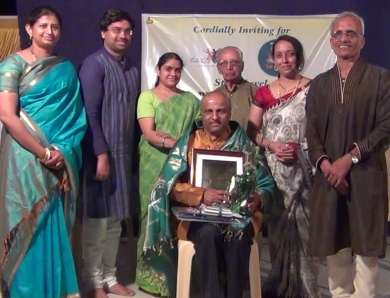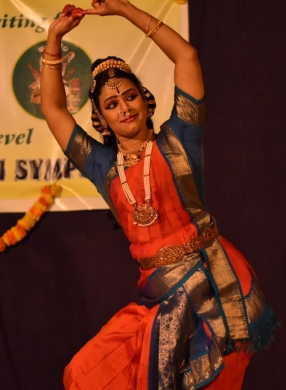
|   |

|   |
Shivaaraadhana through Nrityaadhyayana - Vishnuprasad March 10, 2018 Noopura Bhramari, started by Dr. B.N. Manorama in 2007 is a dance magazine that has evolved into a research journal. It has its own Trust and has achieved many things in the field of art like organizing dance research symposiums, conferences, published books and research articles. Documentation of Karnataka Nritya/ Yakshagana/ Janapada research articles, classes on nattuvangam, Natyashastra, Puranakatha, lakshanagranthas, etc has been undertaken. Orientation programs, competitions, research based dance programs, the critic award for the year, etc. are appreciated by the general public. Kalagowri of Gowri Natyashala started in 2017 by Shalini P Vittal has presented monthly programs without any bias to junior/ senior artists or style/ sub-style etc.  Noopura Bhramari in collaboration with Kalagowri organized a State level dance research symposium on completion of its tenth year on Mahashivarathri by way of 'Shivaaraadhana through Nrithyaadhyayana' at Bengaluru. The morning session started with obeisance to Lord Nataraja, vedic chants, offerings of flowers and fruits. In the afternoon, the research symposium session started with a prayer by Megha Srinivas and welcome speech by Dr. Manorama. The first paper presentation titled 'Theorizing the practicality' started with 'Tracing the adavu through the study of treatises in Sanskrit' by Anupama Jayasimha. Ranjana Nagaraja spoke on 'Symbolic representation of hastas and adavus of Bharatanatyam'. The next lec-dem was on 'Role of nayaka in nayika composition' by Madhulika Srivatsa. Deeptishri Bhat presented a paper on 'Classification, duties of Sakhi and her representation in dance and dramas.' There was a panel discussion followed by demonstration by Divya Shivnarayan on the subject of 'Alaripu - practicality and newness.' The session was witnessed by many students, coming from the whole state of Karnataka. A special lecture by Arjun Bharadwaj (scholar, writer, Bengaluru) was arranged on 'Comparative Art and Aesthetics of India and Greece.' "Akin to the Indian culture, the Greek culture was also closely linked to nature. Unlike the Semitic religions, in ancient Greek culture, both the creator and the creation were revered and worshiped. It is likely that the people who migrated from the Sarasvati-Drshadvati basin in the past, are today's Greeks and thus the close resemblance of the cultures," he said. "Dr. SL Bhyrappa says that myth creation is a sign of a living tradition. The Greeks, who were at their peak in about 4th century BC had great creative and scientific minds. They had stories associated with every place, water body and natural phenomenon, just as we have sthala-purana in India even today. The death of the Greek civilization happened on the coming of the Semitic religions, which not only killed scientific thought but also all art forms. It was only with the coming of renaissance in Europe that classical art found its revival. Natyasastra is an encyclopaedic work which not only teaches the poet and the actor but also trains a sahridaya to appreciate good art. There is unfortunately no parallel to it in any other culture of the world. Aristotle's 'Poetics' mainly deals with dramaturgy and gives us the yardsticks to measure the worth of a piece of art. It however does not tell us how good art can be produced. While catharsis is purging of emotions as a result of art, Rasananda is the experience of bliss due to the enjoyment of art. Although there are some such differences in the two cultures, it is for certain that they share the same umbilical cord." Arjun opined that the Greek art forms can be considered a desi form of the pan-Indian marga laid down by Bharata. Arjun Bharadwaj's presentation included a chronology of sculptures, paintings and mosaics from different eras of Europe. He brought out parallels between art forms and aesthetic principles of Greece and India. Arjun also explained how classical art has today taken the shape of 'modern art.'  K.N. Anantharamaiah  Subbukrishna The evening program saw the release of Noopura Bhramari's 10th Anniversary Online Research Journal issue. The eighty year old K.N. Anantharamaiah (organizer, BTM Cultural Academy) received the title 'Kalayojana Koushika' and Subbukrishna (writer and organizer) received 'Sahrdayi Sadratna.' Anantharamaiah said that, "the outcome through sincerity and discipline in the arts can be felt in our ways of life too. Anything done for the sake of art becomes a support and stands as our backbone." Completeness is achieved by a talented artist in combination with an emotional sahrudayi, like Subbukrishna, who has been organizing monthly programs in his own Krishna Kalakendra institution. In his presidential speech, senior theatre artist Korgi Shankarnarayan Upadhyaya said that, "Indian art and culture is so vast that all our understanding is limited by our own perceptions of it just like the blind understand the magnitude of an elephant only by touching its parts. Hence it is difficult to fully realize the usefulness of the vision and the purpose behind this symposium at once. Newer innovations can come only when we understand the values of the past and analyze them. A new search in the field opens up thought provoking, inspiring and innovative minds. Water should never get stagnant. But the flow of art can become still in the minds of rasikas as an everlasting impact of enjoyment. This will become the pramana for rasa." He also said that 'there is nothing called new research. But an individual in the journey of search gives something new which helps in sustenance. Research is a long chain. Without the basic foundation, it cannot be done. In the present scenario, where research is being stolen, a person who has at least respected the values of the hidden past and gives a new perspective is much better comparatively. A person should move a step further and get involved in research in addition to collecting and documenting information. Even while presenting, a researcher should present the ways of his understanding rather than the information provided in the books. A dance researcher should implement the practical adaptations which helps the audience too." The evening session witnessed Bharatanatyam program by Megha Srinivas and Sangeeta Iyer (disciples of Dr. Shobha Shashikumar). The Badami Mahanata Kouthvam and Mayura Alarippu were well appreciated. Mayura Alarippu was performed by Sangeeta Iyer as invocatory piece, retaining the traditional structure of an alarippu - to be performed in three levels of sama, araimandi and muzhumandi, and in three speeds. Traditionally, an alarippu is interpreted as the blooming of a flower - where the dancer is the flower, and she blooms to perform the rest of the margam. Sangeeta interpreted it as a peacock, which get inspired by clouds and dances in its own way. She brought various karanas into this piece. Megha Srinivas presented Mahanata Kouthvam (based on the Mahanata-Shiva sculpture of Badami) composed by Manorama in Ragamalika and set to khandachapu tala. Here the sutradhara visualized Mahanata as the one trying to please his dear consort Parvathi, who is upset that her Shiva is dancing with Ganga. Shiva becomes the Mahanata and performs the karanas because he knows that dancing is easiest way to calm his Parvathi and pacify her. He performs Apaviddham, Nikuttkam, Rechitanikkuttitam, Akshptam, Sarpitam, Mattali, Ardhamatalli, Valitam, Lalitam, Dolapada, Bhujanagatrastarechitam, Bhujangatrasitam for goddess Parvathi. Parvathi happily thinks to herself that she needs no convincing about his love for her and begins to dance along with him. She performs Avartam, Prushtaswastikam, Vakshasvastikam, Ardhasvastikam, upasrtakam along with Shiva. The sutradhara perceives Shiva and Shakti as 'one' and explains how both the energies are manifested in the same body and how they stand together as Ardhanaarishwara. Ganesha, who watches the beautiful dance of Shiva and Parvathi, comes in between to show off his dancing skills and performs Karihasta. In concluding, sutradhara says that this Mahanata who shows himself in the human form is the greatest of the dancers and that his dance is a Veda for the dancers today and just one glance from this great Mahanata would bring all the happiness and contentment. These were all beautifully portrayed by Megha.  Megha Srinivas  Sangeeta Iyer 'Aartha Piravi Tuyarkeda' composition of Manickavasagar was portrayed by Sangeeta Iyer. This song is taken from Tiruvempavai based on the Tiruvannamalai temple. Pavai means young maiden. In the month of December- January, young girls observe a penance called Pavai Nombu, during which they visit the Annamalai temple every day of the month, bathe in the temple tank and offer prayers to Siva, so he will bless them with a good husband. The situational context was the temple tank. All songs are composed as if being sung by these young girls while bathing in the tank before prayer. Manickavasagar was a 9th century Tamizh Saivite saint poet- who along with Appar, Sundarar, and Sambandar- is one of the four most important Saivite saints of the Bhakti period. Their compositions, together, called the Tirumurai, form the foundations of Tamizh Saivite philosophy. The 12th song, which was presented by Sangeeta, spoke of the attributes of Siva as the cosmic dancer Nataraja in Chidambaram. "Singing his praises, and thinking of his great attributes, let us bathe in this tank, my dear girls." Their bangles are jingling, their hair swaying, and their ornaments hiss, as they bathe in the Poigai river, which has beautiful flowers all over it surrounded by buzzing bees. The girls fix their mind on Siva, and sing only his praise. The piece was set to Shankarabharanam raga and adi tala. Megha performed kriti composed by R. K. Padmanabha, set to Nayaki raga and khandachapu tala, describing the beauty of goddess Lakshmi who is called Soumyanayaki because of her grace, elegance and charming beauty which equals not 1 or 2 but a hundred Urvashis. Sangeeta selected the first song of Tyagaraja's Nauka Charitram -Sringarinchukoni vedaliri, set to Surutti ragam and adi talam. The story is of Krishna's meeting with the gopikas at scenic Yamuna river and taking them all on a boat ride. Each one is dressed up, preparing in a different way to entice him. As the story unfurls, we see how the pride and ego of the gopikas is removed by Krishna and his leelas. Antahpurageethe composed by D. V. Gundappa set to Behag raga and adi tala was concluding piece performed by Megha Srinivas. Here the sakhi finds her good friend talking to a parrot and enquires what message she is sending with the parrot and to whom. The sakhi asks Shukabhaashini to share both the matters that she is upset with and also those that make her happy. Sakhi tells her to stop sending messages and instead meet her lord as he is very upset at not having met her. She questions Shukabhaashini if she could find no messenger other than the parrot to communicate about her love for lord Channakeshava. Sakhi complains that Shukabhaashini has neglected her good friend and requests to be appointed as the messenger as she would do a better job than the parrot. Priyankaari Krishnan and Varsha R Krishna on vocal, Madhulika Srivatsa on nattuvangam, Bettavenkatesh on mridangam, and Skanda Kumar on flute supported and brought a good feel. |